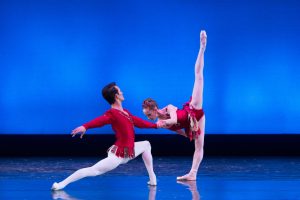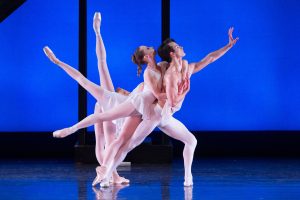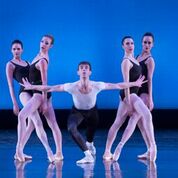It’s the Music! It’s the Dance! City Ballet’s Balanchine Masterpieces Wows
City Ballet of San Diego started a company orchestra in 2006, and initially the sound left much to be desired. But conductor John Nettles kept developing the group and recruiting more seasoned musicians. In last weekend’s “Balanchine Masterpieces” program, the music proved as thrilling as the dance—especially Mark Polesky at the piano.
Two of the program’s three works, “Rubies” and “The Four Temperaments,” have scores that feature piano—Stravinsky’s Capriccio for Piano and Orchestra and Hindemith’s Four Temperaments for Piano and Strings, respectively. Polesky brought brightness and verve to the Stravinsky and richness to Hindemith’s changing moods. And that was on an electric keyboard!

Iago Breschi and Ariana Gonzalez in “Rubies.” Photo: Chelsea Penyak
The dance (seen on Saturday night) was equally stunning, from the moment the Spreckels Theatre curtain rose on a chorus line of dancers in sparkly lipstick-red, jutting their hips, in “Rubies.” George Balanchine made “Rubies” to reflect the sass of New York City. (The full “Jewels” also includes “Emeralds,” which evokes Paris, and the wintry Russian “Diamonds.”)
“Rubies” is quick and playful, with canted torsos, pony prances, and sometimes-flexed ankles and wrists. The costume for the female principal at New York City Ballet has genuine rubies in the skirt, and Ariana Gonzalez danced as if she were a gem-wearing queen. She ruled in several flirty pas de deux with Iago Breschi, deigning to let him support her in dazzling extensions. Her commanding presence contrasted deliciously with airy soloist Megan Jacobs, as the soubrette deftly juggling multiple suitors.
A dashing partner in “Rubies,” Breschi brought his own star power to the title role in “Apollo.” Created for the Ballets Russes in 1928, the work’s dramatic set, by French artist André Bauchant, features a tall staircase (just stairs, no railing), seen from the side, against a background drenched in Greek-sky blue lighting. The dance—set to Stravinsky’s Apollo—begins with the god’s mother writhing in labor at the top of the staircase. Newborn Apollo takes his first tentative steps, then comes into his power and dances with three muses, often holding hands and twining into “how did they get there?” positions.

The signature moment in “Apollo.” Photo: Chelsea Penyak
Breschi was every inch the full-grown god, with impeccable lines and assured partnering, including an electric pas de deux with Gonzalez as Terpsichore, the muse of dance. And the work’s signature moment, when the muses (Gonzalez, Sumire Ito, Tiffany Arroyo) stand in a vertical row behind Apollo and go into arabesque, each raising her leg to a different level for a sculptural effect, was breathtaking. When it comes to baby Apollo’s awkwardness, though, I have a fondness for Timothy Coleman in the company premiere of this dance in 2006.
“The Four Temperaments” let City Ballet show off the depth of its male roster, with strong solos by Lucas Ataide and Brian Heil. Ataide’s riveting Melancholic had a brooding Hamlet smolder. Heil, as the laid-back Phlegmatic, danced with clarity yet managed to convey the impression that he’d smoked a joint before going onstage. Geoff Gonzalez, partnering Ito in Sanguinic, offered a sprightly mood elevator.

Brian Heil in “The Four Temperaments.” Photo: Chelsea Penyak
Jacobs brought flashing legs and fire to Choleric. In a delicious passage, a piano-orchestra dialogue in the score is echoed by Jacobs dancing to Polesky’s piano and the corps coming in with the orchestra. In the exuberant, full-cast finale, lifts occur as if at random—there’s one here, another three seconds later across the stage—as if they’re all saying hurray!
Sadly, this show ran last weekend only. It would be wonderful to have enough funding—and enough of a San Diego ballet audience—that when City Ballet prepares a program of this quality, they can present it for a multi-week run.
